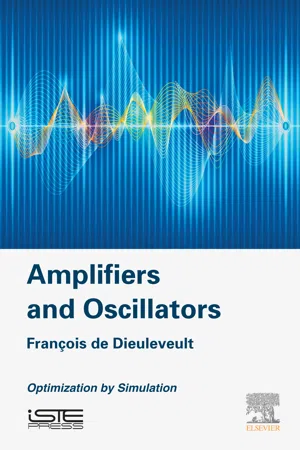
Amplifiers and Oscillators
Optimization by Simulation
- 418 pages
- English
- ePUB (mobile friendly)
- Available on iOS & Android
Amplifiers and Oscillators
Optimization by Simulation
About this book
Amplifiers and Oscillators Optimization by Simulation provides a comprehensive resource on the topic, including theory and simulation. The book presents a panorama of electronic patterns, from the simple, to the more complicated. Comparisons of different structures and their advantages and disadvantages are included, making this the go-to book for engineers who need to quickly find the characteristics of a circuit and the method of calculation and dimensioning of components that fit a particular design.- Explains the theory of amplifiers and oscillators in detail- Includes examples and comparisons of different structures- Provides the go-to book for engineers who want to quickly find the characteristics of a circuit and the method of calculation and dimensioning of components that fit a particular design
Frequently asked questions
- Essential is ideal for learners and professionals who enjoy exploring a wide range of subjects. Access the Essential Library with 800,000+ trusted titles and best-sellers across business, personal growth, and the humanities. Includes unlimited reading time and Standard Read Aloud voice.
- Complete: Perfect for advanced learners and researchers needing full, unrestricted access. Unlock 1.4M+ books across hundreds of subjects, including academic and specialized titles. The Complete Plan also includes advanced features like Premium Read Aloud and Research Assistant.
Please note we cannot support devices running on iOS 13 and Android 7 or earlier. Learn more about using the app.
Information
The Transistor
Abstract
Keywords
1.1 Modeling of transistors
1.1.1 An input resistance and a linked source

Table of contents
- Cover image
- Title page
- Table of Contents
- Copyright
- Preface
- 1: The Transistor
- 2: Amplifiers
- 3: Differential Amplifiers
- 4: Amplifier Output Stage
- 5: Study and Analysis of Certain Amplifiers
- 6: Study and Analysis of Oscillators
- 7: Low Frequency Oscillators
- 8: High Frequency Oscillators
- 9: Differential Oscillators
- 10: Bonus Oscillators
- Bibliography
- Index